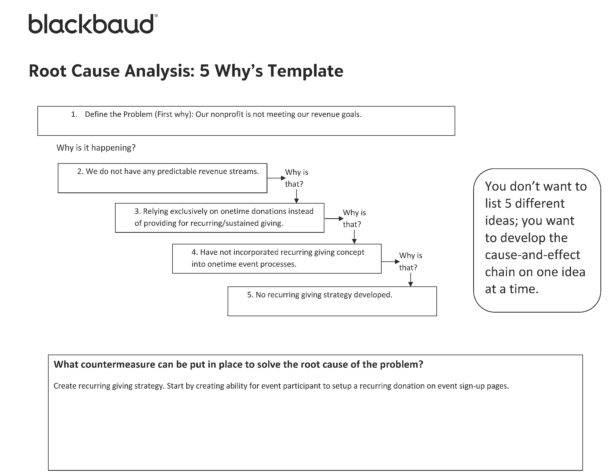Solving Business Problems with Root Cause Analysis

Did you ever wonder why…
- Your solution to a business problem didn’t work?
- Something you thought you fixed keeps having errors?
- You feel like you’re solving the same problem over and over again?
These are frustrating situations. Wouldn’t it be great if there were some tools or techniques we could use to reduce our experiences with them? Good news – there are so let’s learn about one of them called root cause analysis!
Learn more from Sarah about root cause analysis in the ENGAGE Podcast Episode 217: “Business Problem to Solve? Find out the Why”
To throw you some technical speak, root cause is the fundamental breakdown or failure of a process or product, which when resolved and corrected, prevents recurrence of that failure or problem. A bit more basically, it’s a methodology to ensure we aren’t just solving for the symptom of the problem but we’re solving the problem at its root so it will not re-occur in the future.

Think about when you have a cough…you take cough medicine for the symptom of the cough. But after three days of taking cough medicine, it’s getting worse, instead of better. Now it’s time to enlist the help of a doctor (a subject matter expert) to help identify what’s really causing the cough, which is a symptom of a potential underlying problem, and address that underlying problem so our cough goes away for good.
Root cause analysis helps us to solve a problem by getting to the root of it! We do this by looking at the entire cause and effect chain and then solving the problem by developing a countermeasure (an action plan to ensure the problem does not happen again) at the lowest point that you can affect.
It’s easy to jump to solution! It’s in our nature – we want to correct things quickly and despite our best intentions to try to problem solve, sometimes the solutions we implement only end up addressing the symptom. Root cause analysis ensure you’re solving for the systemic reason a problem is occurring, not the symptom. It’s also a collaborative technique to engage subject matter experts in identification of the true root cause of the problem. Subject matter experts are functional area participants, business partners, or customers – the power of this technique is bringing people together to solve the problem. You don’t have to have all the answers – collaborating with a team of subject matter experts brings the expertise to solve the problem to the table.
Alright, let’s talk about how we do this! Root cause analysis is a simple technique, so let’s walk through it in three easy steps: Describe, Identify, Action.
STEP 1: DESCRIBE – Describe the business problem to solve (the effect)
In this step you define the problem you are trying to solve. You will also want to identify who the subject matter experts are that could help determine why this problem might be happening.
STEP 2: IDENTIFY – Identify the cause-and-effect chain related to that problem
In this step, we’re going to use a simple technique called “The 5 Why’s”:
- Start with the symptom, ask why that happened
- For each response, ask why again
- Continue until you cannot go further, it may be more or less than 5
- Drill down to the heart of the problem
- Look for the systemic issue such as process, tools, procedures, training, rather than the performance of an individual
To re-iterate, the great value of this technique is from engaging subject matter experts on a guided conversation to get to root cause. This doesn’t have to be a heavy lift; in 15-30 mins you can perform the 5 Why’s with your subject matter experts! The main challenge in facilitating root cause analysis is to drill down on the same idea before moving to another root cause.
STEP 3: ACTION – Identify the actionable cause of the problem to go solve for
In this step, the team will then identify the lowest level root cause they think is most important to fix and determine an action plan for how it should be fixed. Sometimes doing a pilot test of a new process change might be a good idea to validate it does in fact prevent the root cause from happening going forward.
Let’s go through an example that may be relevant to some in the social good sector:

- If you’re an individual contributor, talk to your manager about this technique and how to engage others in your organization to participate.
- If you lead a team, explain it during your next team meeting and ask for suggestions on a business problem to apply it toward.
